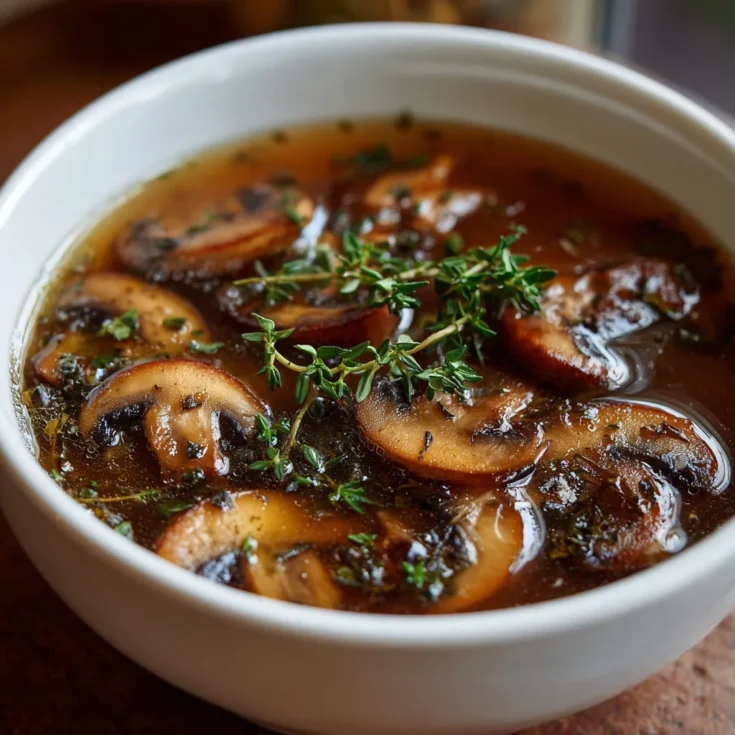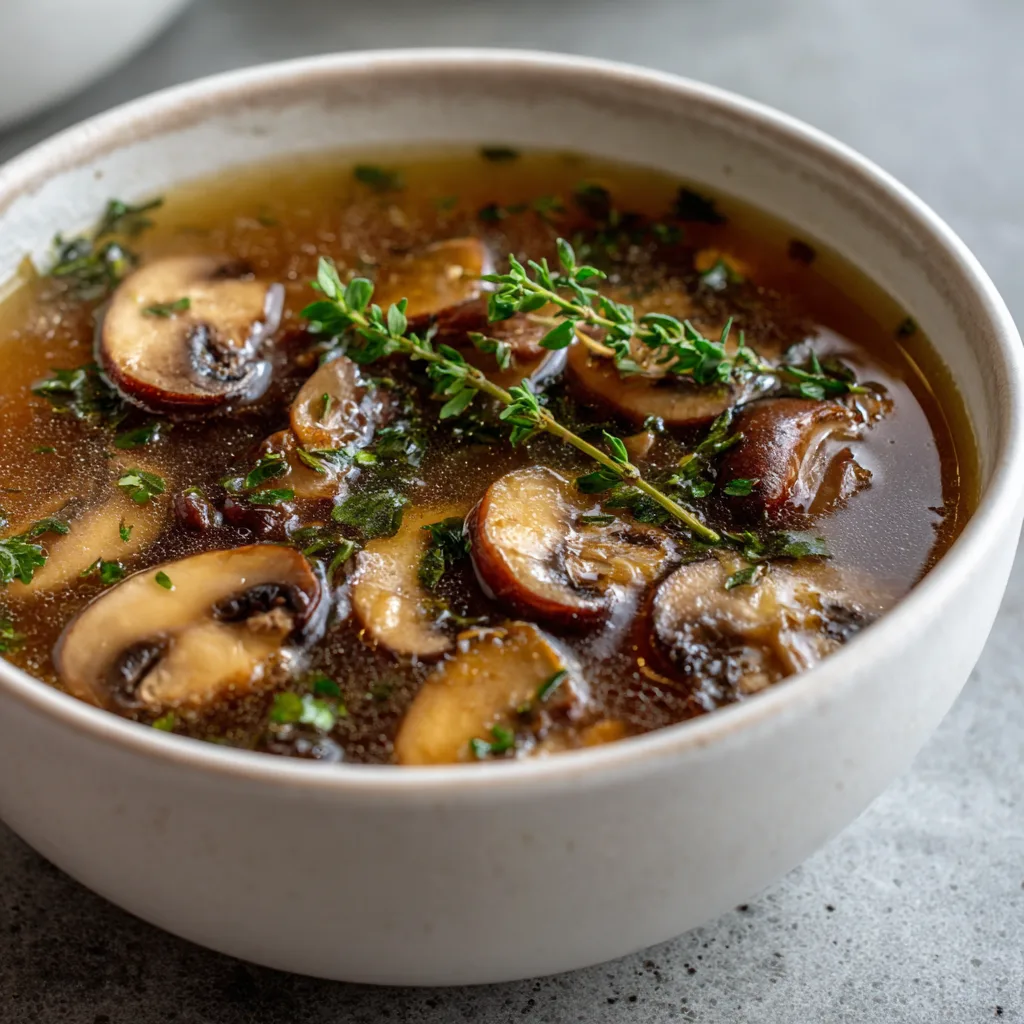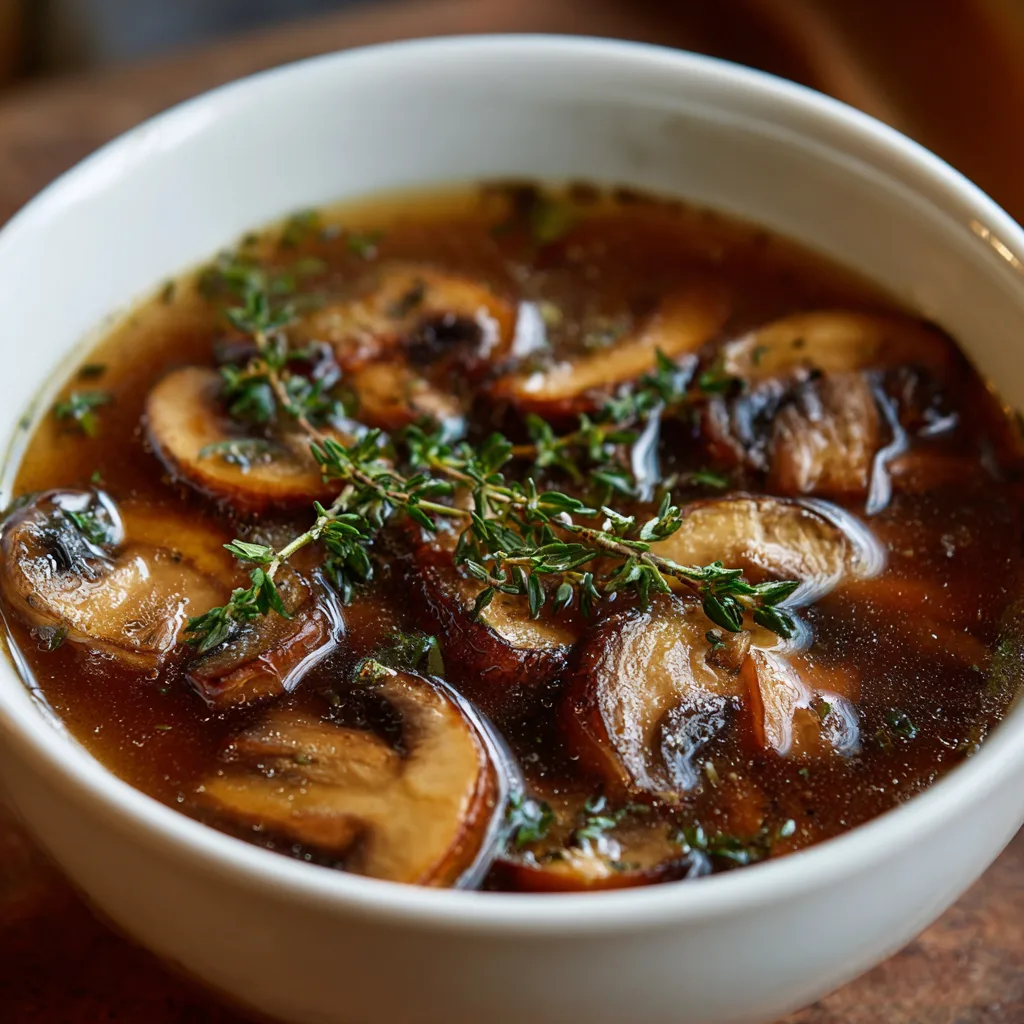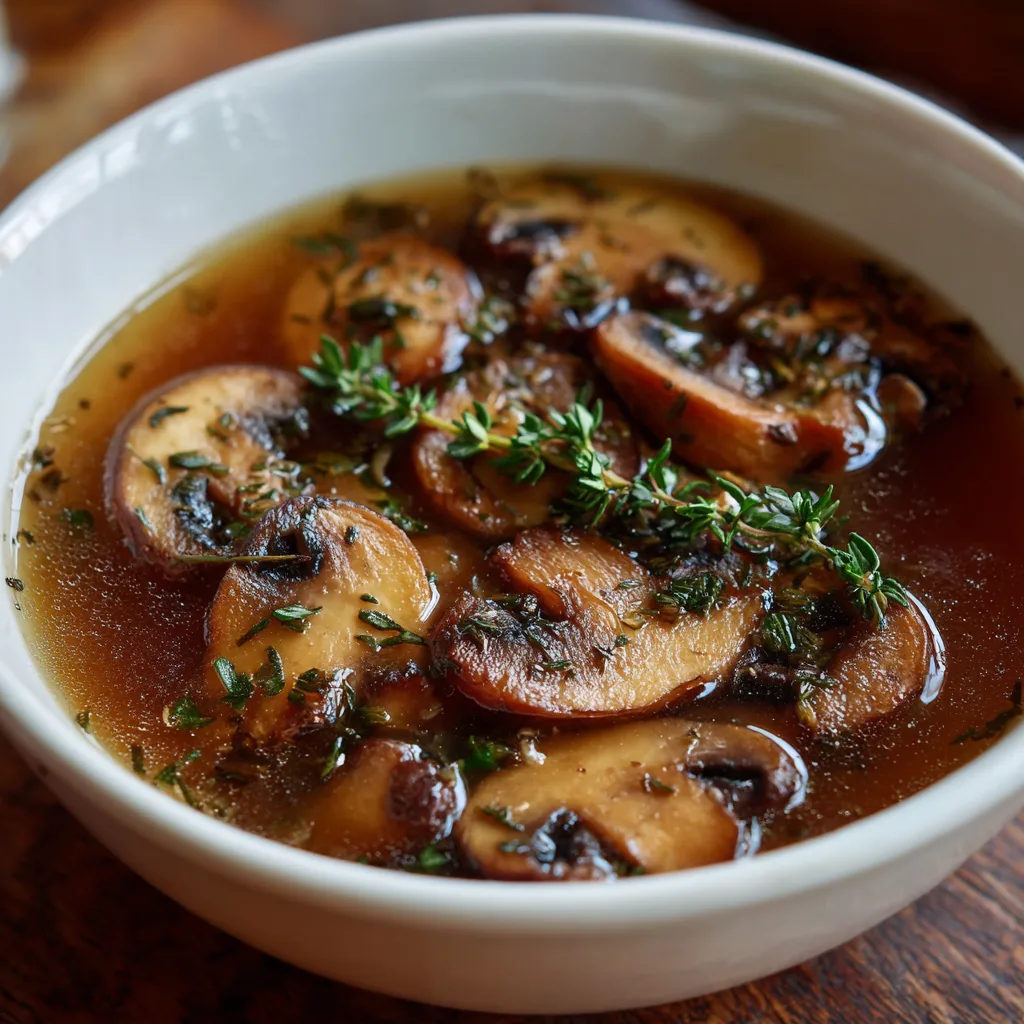Crockpot Mushroom Broth – A Flavorful, Nutritious Base for Your Cooking
Mushroom broth has gained popularity as a versatile, rich, and healthy cooking base. It offers a deep umami flavor that elevates a wide range of dishes. This plant-based broth serves as a nourishing alternative to traditional meat stocks, perfect for vegetarians, vegans, and health-conscious cooks alike. Using a crockpot to prepare mushroom broth has become a favored method for many home chefs seeking convenience and depth of flavor.
Slow cooking mushrooms in a crockpot allows their natural earthiness and nutrients to fully infuse the broth. The gentle, extended heat releases more flavor compounds than quick stovetop simmering. Additionally, crockpots simplify the process by requiring minimal attention, making it easy to prepare broth without fuss. They also use less energy compared to conventional cooking methods, aligning with eco-friendly kitchen practices.
This article will guide you through everything you need to know about crockpot mushroom broth. You’ll discover what sets mushroom broth apart from other similar liquids. You will learn how slow cooking enhances its taste and nutrition. Plus, we will share essential preparation tips, ingredient ideas, and uses to help you master this flavorful broth at home.
What Is Mushroom Broth? Understanding Mushroom Broth, Stock, and Soup
Mushroom broth is a clear, flavorful liquid made by simmering mushrooms with water and aromatics. Unlike mushroom stock, which typically includes vegetable scraps or bones for extra gelatin and richness, mushroom broth focuses primarily on the mushroom essence itself. Meanwhile, mushroom soup contains pureed mushrooms and other ingredients to create a creamy, thicker dish rather than a cooking base.
This broth’s versatility allows it to enrich soups, stews, sauces, risottos, and grain dishes. It adds a subtle yet profound umami note, enhancing the overall flavor without overpowering. Whether you want a vegan stock substitute or a nutrient-packed cooking liquid, mushroom broth is a valuable kitchen staple.
Benefits of Using a Crockpot for Mushroom Broth: Flavor, Convenience, and Efficiency
Slow cooking mushroom broth in a crockpot unlocks a depth of flavor impossible to achieve with rapid boiling. The low and steady heat gently breaks down mushrooms, releasing their natural glutamates and antioxidants into the broth. This process intensifies the savory taste while preserving delicate nutrients.
Using a crockpot makes broth preparation hassle-free. Simply add ingredients, set the timer, and let the device do the work. You can attend to other tasks while the broth simmers quietly for hours. This hands-off approach suits busy lifestyles and beginner cooks alike.
Moreover, crockpots consume less electricity than stovetop simmering, making them energy-efficient. This slow-cooking method also minimizes the risk of boiling over or burning, resulting in a cleaner kitchen experience. Overall, the crockpot offers a smart and sustainable way to make mushroom broth with rich flavor and ease.
Essential Ingredients for Crockpot Mushroom Broth: Choosing the Best Mushrooms and Flavor Enhancers
Selecting the right mushrooms is key to crafting a rich and savory broth. Shiitake mushrooms offer a deep, woodsy flavor that enriches the liquid with natural umami. Cremini and button mushrooms provide a mild, earthy base that balances stronger tastes. Porcini mushrooms, whether fresh or dried, add an intense, nutty aroma that enhances complexity. Combining several types of mushrooms creates layers of flavor that elevate the broth’s profile.
Complementary vegetables contribute sweetness and depth. Onions, garlic, carrots, and celery are classic choices. Onions add a subtle sweetness, while garlic brings a warm pungency. Carrots introduce a gentle earthiness, and celery imparts freshness and slight bitterness, balancing the broth. These vegetables also release nutrients that enhance the broth’s nutritional value.
Herbs and spices play a vital role. Fresh or dried thyme lends a gentle herbal note. Bay leaves contribute subtle aromatic complexity. Whole black peppercorns add a mild heat and bright contrast. These seasonings blend harmoniously with the mushrooms, creating a well-rounded flavor.
To boost umami further, add flavor enhancers like soy sauce or tamari for a salty depth. Miso paste, rich in fermented flavor, can be stirred in after cooking to avoid bitterness. Kombu seaweed offers a natural glutamate boost, ideal for enhancing savory notes without overpowering the broth. Use filtered water or a light vegetable broth as your liquid base to keep the flavors clean and pure.
Preparing Mushrooms and Ingredients for Broth: Clean, Chop, and Enhance
Proper preparation ensures the best extraction of flavors. Start by gently wiping mushrooms with a damp cloth or soft brush to remove dirt. Avoid soaking them in water, which can cause sogginess and dilute flavor. Slice mushrooms into even pieces to maximize surface area and allow thorough simmering.
Prepare vegetables by roughly chopping onions, carrots, and celery into large chunks. Smash garlic cloves to release oils without breaking them apart completely. Bundle herbs with kitchen twine if using fresh sprigs to simplify removal after cooking.
For a deeper flavor, consider pre-roasting or sautéing mushrooms and vegetables. Lightly roasting brings out caramelized notes that enrich the broth. Sautéing mushrooms in a small amount of oil until golden intensifies their umami and adds complexity. While this step is optional, it can significantly improve the broth’s taste.
Crockpot Setup and Cooking Process: Maximize Flavor and Avoid Bitterness
Choose a crockpot with a 4-6 quart capacity to accommodate the ingredients and allow room for simmering without overflowing. Set the crockpot on low heat to gently extract flavors over 6 to 8 hours. This slow and steady cooking prevents mushroom bitterness that can occur with high heat.
Layer ingredients thoughtfully. Start with harder vegetables like carrots and celery at the bottom, then add mushrooms on top. Pour in water or broth last to cover ingredients fully. Add herbs and spices last to preserve their aromatic qualities.
Avoid overcooking by checking the broth at the 6-hour mark. Overcooked mushrooms may turn bitter and impart off-flavors. If needed, adjust cooking time based on your crockpot’s performance. Stir the broth gently once or twice to distribute flavors evenly.
Finally, strain the broth through a fine mesh sieve or cheesecloth to remove solids. This step ensures a clear, flavorful liquid ready to use in your favorite recipes. Following these tips guarantees a savory, nutrient-rich mushroom broth with balanced, clean taste.
How to Use Crockpot Mushroom Broth in Recipes: Versatile Cooking Applications
Crockpot mushroom broth serves as an excellent base for a variety of dishes. It adds rich umami flavor to soups and stews, enhancing depth without overpowering other ingredients. Use it to replace or complement traditional vegetable or chicken broth in your favorite recipes for a more robust taste.
This broth also works beautifully for cooking grains like rice, quinoa, or barley. Simmering grains in mushroom broth infuses them with subtle earthiness, elevating simple side dishes. Similarly, legumes such as lentils and beans absorb the broth’s savory notes, making plant-based meals more satisfying.
Sauces and gravies benefit from the broth’s concentrated flavor. Use it to deglaze pans or as a liquid base for reduction sauces. Its natural richness thickens and deepens sauces, perfect for vegetarian dishes that need a flavorful boost.
Vegetarians and vegans especially appreciate mushroom broth for its ability to mimic the savory depth of meat-based stocks. It forms the foundation for countless plant-based recipes, providing both flavor and nutrition without animal products.
Flavor Variations and Customizations: Tailoring Mushroom Broth to Your Taste
Customize your crockpot mushroom broth to suit different culinary styles and preferences. Adding umami enhancers such as miso paste or nutritional yeast after cooking boosts savoriness and complexity. These ingredients enrich the broth without adding salt, making them ideal for low-sodium diets.
Explore regional flavors by incorporating spices and herbs typical of various cuisines. For an Asian twist, add ginger, star anise, or lemongrass during cooking. Mediterranean profiles benefit from rosemary, oregano, or a splash of lemon juice after cooking. These adjustments transform the broth into a versatile base for international dishes.
Experiment with mushroom varieties for unique depths of flavor. Dried porcini offer a robust, smoky note, while maitake or enoki mushrooms contribute delicate, fragrant undertones. Mixing fresh and dried mushrooms creates a multi-layered broth that suits diverse recipes.
Adjust seasoning carefully to accommodate dietary needs. Use low-sodium soy sauce or tamari to keep salt levels down. Ensure all added ingredients are gluten-free if necessary. This flexibility allows mushroom broth to fit seamlessly into many healthy eating plans.
Storage and Shelf Life: Keeping Your Mushroom Broth Fresh and Safe
Proper storage extends the usability of your mushroom broth. Once cooled, transfer it to airtight containers and refrigerate. The broth typically stays fresh for up to five days in the fridge. For longer storage, freeze the broth in portions using freezer-safe containers or ice cube trays.
When reheating, thaw frozen broth overnight in the refrigerator or gently warm it on the stove over low heat. Avoid rapid boiling to preserve delicate flavors and prevent bitterness. Stir occasionally for even heating.
Watch for signs of spoilage before use. Sour smell, cloudy appearance, or mold growth indicate the broth has gone bad and should be discarded. Fresh mushroom broth maintains a clear, earthy aroma and a pleasant, savory taste. Following these storage tips ensures your broth stays delicious and safe for future meals.
Nutritional Profile of Mushroom Broth: Vitamins, Minerals, and Hydration
Mushroom broth delivers a wealth of nutrients from the mushrooms and vegetables used in preparation. Mushrooms contain essential vitamins like B-complex (B2, B3, B5) that support energy metabolism. They also provide minerals such as potassium, selenium, copper, and zinc, which play vital roles in bodily functions. Additionally, mushrooms are rich in antioxidants like ergothioneine and glutathione, compounds that help protect cells from damage.
This broth remains low in calories and fat, making it an excellent option for light, nutrient-dense cooking. Since it is primarily water infused with flavors and nutrients, it supports hydration while adding taste to meals. This combination benefits those seeking both nourishment and fluid intake without excess calories.
Health Benefits of Regular Mushroom Broth Consumption: Immunity, Inflammation, and Digestion
Consuming mushroom broth regularly can strengthen the immune system. Mushrooms contain beta-glucans, natural compounds known to enhance immune response and promote overall health. Their antioxidants also help reduce oxidative stress, which contributes to inflammation and chronic diseases.
Mushroom broth’s anti-inflammatory properties support joint and heart health by lowering inflammation markers. It aids digestion by providing prebiotic fibers that foster beneficial gut bacteria. This digestive support can improve nutrient absorption and reduce gastrointestinal discomfort.
Some studies suggest that mushroom components may help regulate blood pressure and cholesterol levels. While broth alone is not a cure, incorporating it into a balanced diet can contribute to cardiovascular wellness over time.
Who Should Consider Mushroom Broth? Ideal for Various Diets and Health Needs
Mushroom broth suits vegetarians and vegans perfectly, offering a flavorful, animal-free alternative to meat-based stocks. It fits well into plant-based and cleansing diets due to its nutrient density and low calorie content.
People with food allergies or sensitivities should check ingredient choices carefully. Most mushroom broth recipes avoid common allergens, but it’s wise to verify seasonings like soy sauce or added flavorings. Homemade broth allows full control over ingredients, making it easier to adapt for individual dietary needs.
Overall, mushroom broth is a nourishing, versatile option for anyone seeking a healthy, flavorful cooking base that supports wellbeing and diverse eating styles.
FAQs About Crockpot Mushroom Broth
What is the difference between mushroom broth and mushroom stock?
Mushroom broth is a clear, flavorful liquid made mainly from mushrooms and aromatics. Mushroom stock often includes vegetable scraps or bones to add body and gelatin. Broth tends to be lighter, while stock is richer and thicker.
Can I use dried mushrooms for crockpot mushroom broth?
Yes, dried mushrooms work well. They add intense flavor and deepen the broth’s umami. Soak them in water before adding to the crockpot, or include them directly and adjust cooking time slightly.
How long should mushroom broth be cooked in a crockpot?
Cook the broth on low heat for 6 to 8 hours. This slow, gentle cooking extracts maximum flavor without turning the mushrooms bitter.
Is crockpot mushroom broth vegan and gluten-free?
Typically, yes. It contains no animal products and uses gluten-free ingredients by default. Just double-check any added sauces or seasonings for hidden gluten.
How do I prevent mushroom broth from tasting bitter?
Avoid cooking on high heat or for too long. Pre-roasting mushrooms gently before slow cooking also helps develop sweeter, richer flavors that reduce bitterness.
Can mushroom broth be used as a substitute for chicken broth?
Absolutely. Mushroom broth offers similar depth and umami, making it an excellent plant-based substitute in most recipes.
How long does crockpot mushroom broth last in the fridge?
Stored in airtight containers, it stays fresh for up to five days.
Can I freeze mushroom broth?
Yes, freezing extends its shelf life up to three months. Freeze in portions for easy use later.
Crockpot Mushroom Broth – Flavorful & Nourishing Homemade Broth

This rich, savory mushroom broth slowly simmers in a crockpot, drawing out deep umami flavors. It serves as a nourishing base perfect for soups, sauces, and countless dishes needing a flavorful boost.
Ingredients
- 500g mixed mushrooms (shiitake, cremini, button, dried porcini optional)
- 1 large onion, quartered
- 3 garlic cloves, smashed
- 2 medium carrots, chopped
- 2 celery stalks, chopped
- 1 tablespoon olive oil (optional)
- 1-2 bay leaves
- 1 teaspoon whole black peppercorns
- 2-3 sprigs fresh thyme (or 1 tsp dried)
- 6 cups filtered water
- 1 tablespoon soy sauce or tamari (optional, for umami)
- 1 piece kombu seaweed (optional)
Instructions
Notes




